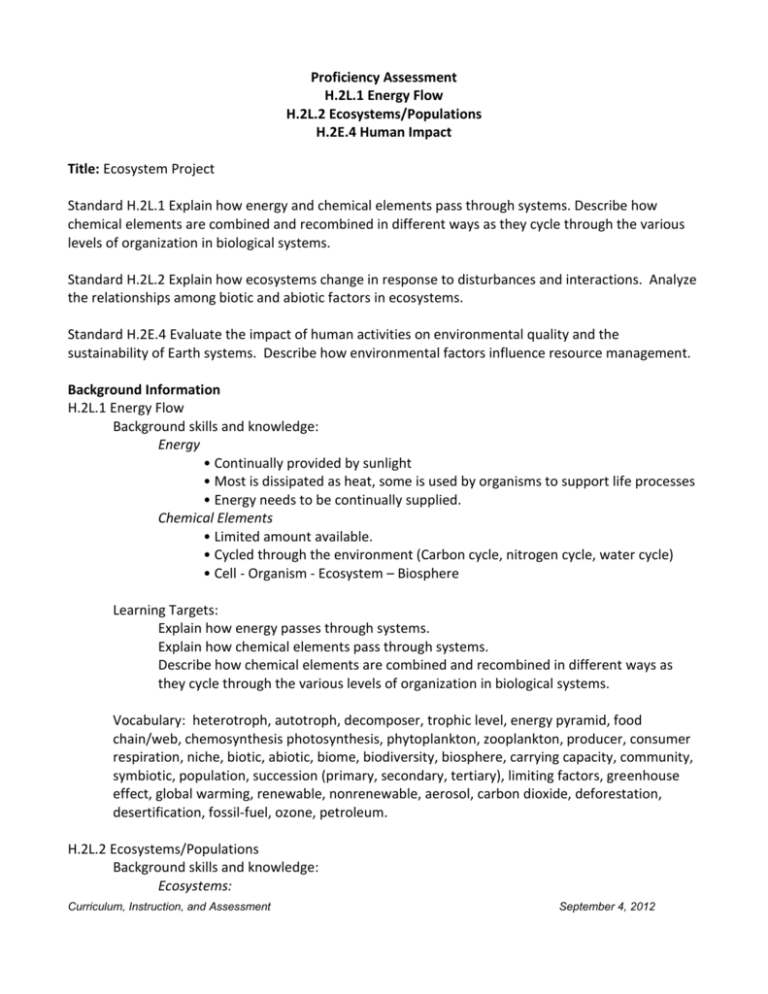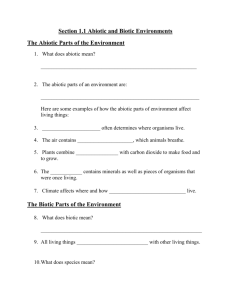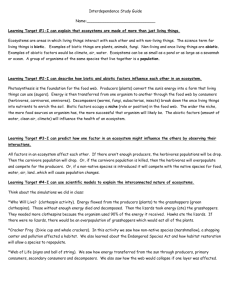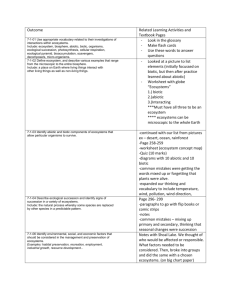H.2L.1 H.2L.2 H.2E.4 Ecosystem Assessment 1
advertisement

Proficiency Assessment H.2L.1 Energy Flow H.2L.2 Ecosystems/Populations H.2E.4 Human Impact Title: Ecosystem Project Standard H.2L.1 Explain how energy and chemical elements pass through systems. Describe how chemical elements are combined and recombined in different ways as they cycle through the various levels of organization in biological systems. Standard H.2L.2 Explain how ecosystems change in response to disturbances and interactions. Analyze the relationships among biotic and abiotic factors in ecosystems. Standard H.2E.4 Evaluate the impact of human activities on environmental quality and the sustainability of Earth systems. Describe how environmental factors influence resource management. Background Information H.2L.1 Energy Flow Background skills and knowledge: Energy • Continually provided by sunlight • Most is dissipated as heat, some is used by organisms to support life processes • Energy needs to be continually supplied. Chemical Elements • Limited amount available. • Cycled through the environment (Carbon cycle, nitrogen cycle, water cycle) • Cell - Organism - Ecosystem – Biosphere Learning Targets: Explain how energy passes through systems. Explain how chemical elements pass through systems. Describe how chemical elements are combined and recombined in different ways as they cycle through the various levels of organization in biological systems. Vocabulary: heterotroph, autotroph, decomposer, trophic level, energy pyramid, food chain/web, chemosynthesis photosynthesis, phytoplankton, zooplankton, producer, consumer respiration, niche, biotic, abiotic, biome, biodiversity, biosphere, carrying capacity, community, symbiotic, population, succession (primary, secondary, tertiary), limiting factors, greenhouse effect, global warming, renewable, nonrenewable, aerosol, carbon dioxide, deforestation, desertification, fossil-fuel, ozone, petroleum. H.2L.2 Ecosystems/Populations Background skills and knowledge: Ecosystems: Curriculum, Instruction, and Assessment September 4, 2012 • Dynamic, not static • All ecosystems are interconnected. • All aspects of ecosystems are interconnected. • Invasive species and ecosystem changes can produce instability. Biotic and Abiotic Factors: • Can be limiting • Can affect population growth • Succession • Niche Types of Symbiotic Relationship • Commensalism • Mutualism • Parasitism Learning Targets: Explain how ecosystems change in response to disturbances Explain how ecosystems change in response to interactions. Analyze the relationships among biotic and abiotic factors in ecosystems. Vocabulary: niche, biotic, abiotic, biome, biodiversity, biosphere, carrying capacity, community, symbiotic, population, succession (primary, secondary, tertiary), limiting factors H.2E.4 Human Impact Background skills and knowledge: Human activities have an environmental impact which affects resource management. Increased consumption of fossil fuels impact habitats, contributes to climate change, stresses natural processes that renew some renewable resource and depletes resources that are nonrenewable. Human activities, such as pesticide use and strip mining, change resources and environment. This may lead to habitat change, landscape changes, resource depletion. Sustainable systems require replenishment. Humans have a responsibility to continue exploring ways to conserve or replace resources. Human activities and their effects have an economic impact that should include a cost/benefit analysis. Learning Targets: Evaluate the impact of human activities on environmental quality. Evaluate the impact of human activities on the sustainability of Earth systems. Describe how environmental factors influence resource management. Vocabulary: greenhouse effect, global warming, renewable, nonrenewable, aerosol, carbon dioxide, deforestation, desertification, fossil-fuel, ozone, petroleum Assessment Curriculum, Instruction, and Assessment September 4, 2012 This three-part project is designed to allow students to explain and describe the flow of energy within an ecosystem and biogeochemical cycles. Following that, students will explain and analyze the effect of an increase and decrease of a species on other parts of an ecosystem, and the effect of abiotic and biotic changes on an ecosystem. In the last part of the project, students will evaluate and describe the impact of human activities on Earth systems. Type: Poster and writing project Time needed: 2-3 class periods for poster, 1-2 class periods for each writing portion Materials: Poster paper, access to research (computers, library or textbooks), paper and pencil – can be typed at teacher’s discretion Directions: Deliver first student task description and scoring guide to students. Give them time to create poster. Deliver second student task description and scoring guide to students. Give them time to write. Deliver third student task description and scoring guide to students. Give them time to write. Curriculum, Instruction, and Assessment September 4, 2012 Student Handout Ecosystem Project – Part 1 H.2L.1 Energy Flow Research You will be working by yourself and time is limited to complete the research. Work quickly and efficiently. Focus on the must-haves, not the if-you-cans, first. Choose a keystone species or biome to provide a direction for research. Inform your teacher of your chosen species. These will be assigned first-come, first-served and you will not be allowed to use a species already taken. Research tip: Identify a list of organisms first, then begin finding out the details. Things to find about your organisms: 1. Common name 2. Scientific name 3. Range (where they live) [this points you in the direction of the ecosystem to research and will tell you what other species live there] 4. Common feeding habits and energy requirements Interesting and may help with extensions but not required: 5. Breeding habits (when, how many offspring) 6. Estimated population (average numbers per unit area would be better here) Poster You will make a food-web poster for a particular biome or ecosystem containing the keystone species. The food web must contain: o At least five food chains consisting of a producer, a primary consumer, a secondary consumer, and decomposer. o Each consumer must be labeled as an herbivore, carnivore, omnivore, or decomposer. o Use scientific names in addition to any common names. o Five abiotic factors also must be included and labeled. o Poster may be drawn freehand, or you may cut and paste pictures from magazines or computer printouts. You will make an ecological pyramid for one of your food chains. Show the relative amount of energy and/or biomass as it flows up your pyramid. Create a pyramid of numbers based on your food chain – Caution: This may not be wider on the base than it is at the top. See Chapters 3.2, 4.2, and 4.3 for vocabulary, and Figure 3-8 for one example of how to display information. You will have 3+ days in the library. Posters are due at the beginning of class on ________. Bring your book to class. Example Keystone Species African Elephant Curriculum, Instruction, and Assessment Beaver September 4, 2012 Black-bellied Salamander Black-tailed Prairie Dog Gopher Tortoise Gray Wolves Grizzly Bears Howler Monkey Jaguar Kangaroo Rat Mountain Lions Pacific Salmon Plateau Pika Red-naped Sapsuckers Sea Otter Sea Star (Pisaster ochraceus) Snowshoe Hare Biomes Marine Ocean Coral Reef Estuary Tropical Rainforest Savanna Scrub Forest Desert Steppe Temperate Deciduous Forest Taiga Arctic Tundra Alpine Tundra Temperate Rainforest Chaparral Prairie Check list Ecosystem Project – Part 1 Include the Following Heading Title Name (First and Last) Date Class Elements Spelling Conventions (capitalization, punctuation, paragraphs) Use vocabulary from state standard: heterotroph, autotroph, decomposer, trophic level, energy pyramid, food chain/web, chemosynthesis photosynthesis, phytoplankton, zooplankton, producer, consumer, respiration See Directions/procedures Scoring See rubric Format Poster with drawing/pictures, connections Written explanation Curriculum, Instruction, and Assessment Evidence = X September 4, 2012 Ecosystem Project – Part 2 H.2L.2 Ecosystems/Populations Research You will be working by yourself and time is limited to complete the research. Work quickly and efficiently. Focus on the must-haves, not the if-you-cans, first. Choose a keystone species or biome to provide a direction for research. Inform your teacher of your chosen species. These will be assigned first-come, first-served and groups will not be allowed to use a species already taken. Research tip: Identify a list of organisms first, then begin finding out the details. Things to find out about your ecosystem/biome: 1. Dominant producer(s) 2. Temperature a. Average b. Range [if you can easily] i. Annual ii. Diurnal (daily) c. Extreme 3. Precipitation a. Amount b. Distribution (season when it falls) [if you can easily] c. Type d. Reliability Poster Add and/or label your food web with: o At least one predator-prey relationship must be shown. o At least one correctly identified symbiotic relationship. Conclusion Once you finish your poster, on a clean piece of notebook paper: 1. Pick one organism from your predator-prey relationship. Explain what would happen to your predator-prey populations if the numbers of your chosen organism went up and what would happen if the numbers went down. 2. Pick one organism from your symbiotic relationship. Explain what would happen to your symbiotic populations if the numbers of your chosen organism went up and what would happen if the numbers went down. 3. Pick one organism from your food web. Explain what would happen to your entire food web if the numbers of your chosen organism went up and what would happen if the numbers went down. 4. Pick an abiotic factor. Explain what would happen to your entire food web if the abiotic factor was removed or limited severely. Curriculum, Instruction, and Assessment September 4, 2012 Check list Ecosystem Project – Part 2 Include the Following Heading Title Name (First and Last) Date Class Elements Spelling Conventions (capitalization, punctuation, paragraphs) Use vocabulary from state standard: niche, biotic, abiotic, biome, biodiversity, biosphere, carrying capacity, community, symbiotic, population, succession (primary, secondary, tertiary), limiting factors See Directions/procedures Scoring See rubric Format Poster with drawing/pictures, connections Written explanation Curriculum, Instruction, and Assessment Evidence = X September 4, 2012 Ecosystem Project – Part 3 H.2E.4 Human Impact Conclusion On a clean piece of notebook paper, explain the impact on your ecosystem of a human activity like: Extinction Overhunting Oil spill Fire Mining Farming Logging Chemical spill Pesticide use Herbicide use Abandonment of domesticated animals (dogs, cats, pigs, goats) Introduction of non-native species OR anything else you can think of humans do than might disturb your ecosystem. Check list Ecosystem Project – Part 3 Include the Following Heading Title Name (First and Last) Date Class Elements Spelling Conventions (capitalization, punctuation, paragraphs) Use vocabulary from state standard: greenhouse effect, global warming, renewable, nonrenewable, aerosol, carbon dioxide, deforestation, desertification, fossil-fuel, ozone, petroleum. See Directions/procedures Scoring See rubric Format Written explanation Curriculum, Instruction, and Assessment Evidence = X September 4, 2012 Scoring Guide H.2L.1 Energy Flow Standard: Explain how energy and chemical elements pass through systems. Describe how chemical elements are combined and recombined in different ways as they cycle through the various levels of organization in biological systems. Score Description: 4.0 Exceeds Explain the interconnection of the linear path of energy and the cyclical nature of matter. 3.5 Can complete level 3.0 and can partially complete level 4.0. 3.0 Meets Explain how energy passes through biological systems. Describe how chemical elements pass through biological systems and how elements are combined and recombined in different ways as they cycle through various levels of organization. 2.5 Can complete level 2.0 and can partially complete level 3.0 or 4.0 2.0 Nearly Meets Recognize that energy and chemical elements can be combined in specific ways as they move through biological systems. 1.5 Can complete level 1.0 and can partially complete level 2.0, 3.0, or 4.0. 1.0 Beginning Recognize that matter and energy move through biological systems in predictable ways, with help 0.5 Can produce some evidence of basic knowledge, with help. 0.0 Has no understanding Cannot provide any evidence of knowledge or understanding, even with help. Curriculum, Instruction, and Assessment September 4, 2012 Scoring Guide H.2L.2 Ecosystems Standard: Explain how ecosystems change in response to disturbances and interactions. Analyze the relationships among biotic and abiotic factors in ecosystems. Score Description: 4.0 Exceeds Predict the response that would occur in an ecosystem due to changes in the biotic and abiotic factors related to that ecosystem. 3.5 Can complete level 3.0 and can partially complete level 4.0. 3.0 Meets Explain how ecosystems change in response to disturbances and interactions. Analyze the relationships among the biotic and abiotic factors in ecosystems. 2.5 Can complete level 2.0 and can partially complete level 3.0 or 4.0 2.0 Nearly meets Describe how biotic and abiotic factors may cause changes in ecosystems. 1.5 Can complete level 1.0 and can partially complete level 2.0, 3.0, or 4.0. 1.0 Beginning Recognize that an ecosystem can change and distinguish between biotic and abiotic factors, with help 0.5 Can produce some evidence of basic knowledge, with help. 0.0 Has no understanding Cannot provide any evidence of knowledge or understanding, even with help. Curriculum, Instruction, and Assessment September 4, 2012 Scoring Guide H.2E.4 Human Impact Standard: Evaluate the impact of human activities on environmental quality and the sustainability of Earth systems. Describe how environmental factors influence resource management. Score Description: 4.0 Exceeds Evaluate methods humans can use to support the sustainability of the Earth’s system utilizing effective and appropriate resource management. 3.5 Can complete level 3.0 and can partially complete level 4.0. 3.0 Meets Evaluate the impact of human activities on the sustainability of the Earth‘s system and how environmental factors influence resource management. 2.5 Can complete level 2.0 and can partially complete level 3.0 or 4.0 2.0 Nearly meets Explain how human activity affects the sustainability of the Earth’s system and identify environmental factors that may influence resource management. 1.5 Can complete level 1.0 and can partially complete level 2.0, 3.0, or 4.0. 1.0 Beginning Describe that human activities impact the sustainability of the Earth’s system and that resources need to be managed, with help. 0.5 Can produce some evidence of basic knowledge, with help. 0.0 Has no understanding Cannot provide any evidence of knowledge or understanding, even with help. Curriculum, Instruction, and Assessment September 4, 2012








